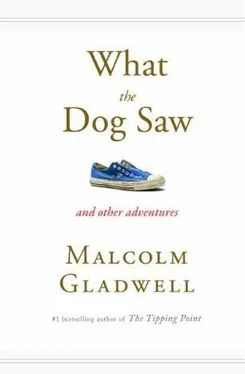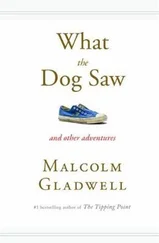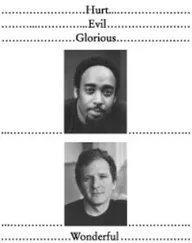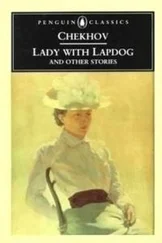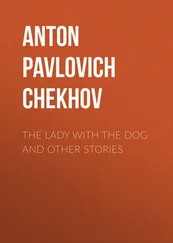Some years ago, an experimental psychologist at Harvard University, Nalini Ambady, together with Robert Rosenthal, set out to examine the nonverbal aspects of good teaching. As the basis of her research, she used videotapes of teaching fellows that had been made during a training program at Harvard. Her plan was to have outside observers look at the tapes with the sound off and rate the effectiveness of the teachers by their expressions and physical cues. Ambady wanted to have at least a minute of film to work with. When she looked at the tapes, though, there was really only about ten seconds when the teachers were shown apart from the students. “I didn’t want students in the frame, because obviously it would bias the ratings,” Ambady says. “So I went to my adviser, and I said, ‘This isn’t going to work.’”
But it did. The observers, presented with a ten-second silent video clip, had no difficulty rating the teachers on a fifteen-item checklist of personality traits. In fact, when Ambady cut the clips back to five seconds, the ratings were the same. They were the same even when she showed her raters just two seconds of videotape. That sounds unbelievable unless you actually watch Ambady’s teacher clips, as I did, and realize that the eight seconds that distinguish the longest clips from the shortest are superfluous: anything beyond the first flash of insight is unnecessary. When we make a snap judgment, it is made in a snap. It’s also, very clearly, a judgment: we get a feeling that we have no difficulty articulating.
Ambady’s next step led to an even more remarkable conclusion. She compared those snap judgments of teacher effectiveness with evaluations made, after a full semester of classes, by students of the same teachers. The correlation between the two, she found, was astoundingly high. A person watching a two-second silent video clip of a teacher he has never met will reach conclusions about how good that teacher is that are very similar to those of a student who sits in the teacher’s class for an entire semester.
Recently, a comparable experiment was conducted by Frank Bernieri, a psychologist at the University of Toledo. Bernieri, working with one of his graduate students, Neha Gada-Jain, selected two people to act as interviewers, and trained them for six weeks in the proper procedures and techniques of giving an effective job interview. The two then interviewed ninety-eight volunteers of various ages and backgrounds. The interviews lasted between fifteen and twenty minutes, and afterward each interviewer filled out a six-page, five-part evaluation of the person he’d just talked to. Originally, the intention of the study was to find out whether applicants who had been coached in certain nonverbal behaviors designed to ingratiate themselves with their interviewers—like mimicking the interviewers’ physical gestures or posture—would get better ratings than applicants who behaved normally. As it turns out, they didn’t. But then another of Bernieri’s students, an undergraduate named Tricia Prickett, decided that she wanted to use the interview videotapes and the evaluations that had been collected to test out the adage that the handshake is everything.
“She took fifteen seconds of videotape showing the applicant as he or she knocks on the door, comes in, shakes the hand of the interviewer, sits down, and the interviewer welcomes the person,” Bernieri explained. Then, like Ambady, Prickett got a series of strangers to rate the applicants based on the handshake clip, using the same criteria that the interviewers had used. Once more, against all expectations, the ratings were very similar to those of the interviewers. “On nine out of the eleven traits the applicants were being judged on, the observers significantly predicted the outcome of the interview,” Bernieri says. “The strength of the correlations was extraordinary.”
This research takes Ambady’s conclusions one step further. In the Toledo experiment, the interviewers were trained in the art of interviewing. They weren’t dashing off a teacher evaluation on their way out the door. They were filling out a formal, detailed questionnaire, of the sort designed to give the most thorough and unbiased account of an interview. And still their ratings weren’t all that different from those of people off the street who saw just the greeting.
This is why Hadi Partovi, Steve Ballmer, and I all agreed on Nolan Myers. Apparently, human beings don’t need to know someone in order to believe that they know someone. Nor does it make that much difference, apparently, that Partovi reached his conclusion after putting Myers through the wringer for an hour, I reached mine after ninety minutes of amiable conversation at Au Bon Pain, and Ballmer reached his after watching and listening as Myers asked a question.
Bernieri and Ambady believe that the power of first impressions suggests that human beings have a particular kind of prerational ability for making searching judgments about others. In Ambady’s teacher experiments, when she asked her observers to perform a potentially distracting cognitive task—like memorizing a set of numbers—while watching the tapes, their judgments of teacher effectiveness were unchanged. But when she instructed her observers to think hard about their ratings before they made them, their accuracy suffered substantially. Thinking only gets in the way. “The brain structures that are involved here are very primitive,” Ambady speculates. “All of these affective reactions are probably governed by the lower brain structures.” What we are picking up in that first instant would seem to be something quite basic about a person’s character, because what we conclude after two seconds is pretty much the same as what we conclude after twenty minutes or, indeed, an entire semester. “Maybe you can tell immediately whether someone is extroverted, or gauge the person’s ability to communicate,” Bernieri says. “Maybe these clues or cues are immediately accessible and apparent.” Bernieri and Ambady are talking about the existence of a powerful form of human intuition. In a way, that’s comforting, because it suggests that we can meet a perfect stranger and immediately pick up on something important about him. It means that I shouldn’t be concerned that I can’t explain why I like Nolan Myers, because, if such judgments are made without thinking, then surely they defy explanation.
But there’s a troubling suggestion here as well. I believe that Nolan Myers is an accomplished and likable person. But I have no idea from our brief encounter how honest he is, or whether he is self-centered, or whether he works best by himself or in a group, or any number of other fundamental traits. That people who simply see the handshake arrive at the same conclusions as people who conduct a full interview also implies, perhaps, that those initial impressions matter too much—that they color all the other impressions that we gather over time.
For example, I asked Myers if he felt nervous about the prospect of leaving school for the workplace, which seemed like a reasonable question, since I remember how anxious I was before my first job. Would the hours scare him? Oh no, he replied, he was already working between eighty and a hundred hours a week at school. “Are there things that you think you aren’t good at that, make you worry?” I continued.
His reply was sharp: “Are there things that I’m not good at, or things that I can’t learn? I think that’s the real question. There are a lot of things I don’t know anything about, but I feel comfortable that given the right environment and the right encouragement I can do well at.” In my notes, next to that reply, I wrote “Great answer!” and I can remember at the time feeling the little thrill you experience as an interviewer when someone’s behavior conforms with your expectations. Because I had decided, right off, that I liked him, what I heard in his answer was toughness and confidence. Had I decided early on that I didn’t like Nolan Myers, I would have heard in that reply arrogance and bluster. The first impression becomes a self-fulfilling prophecy: we hear what we expect to hear. The interview is hopelessly biased in favor of the nice.
Читать дальше
